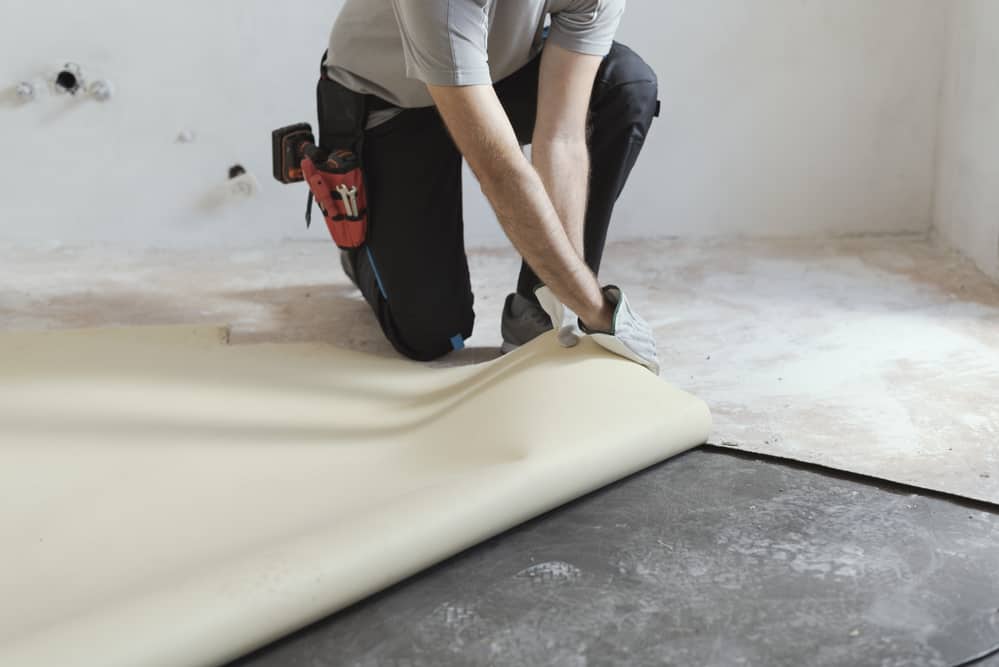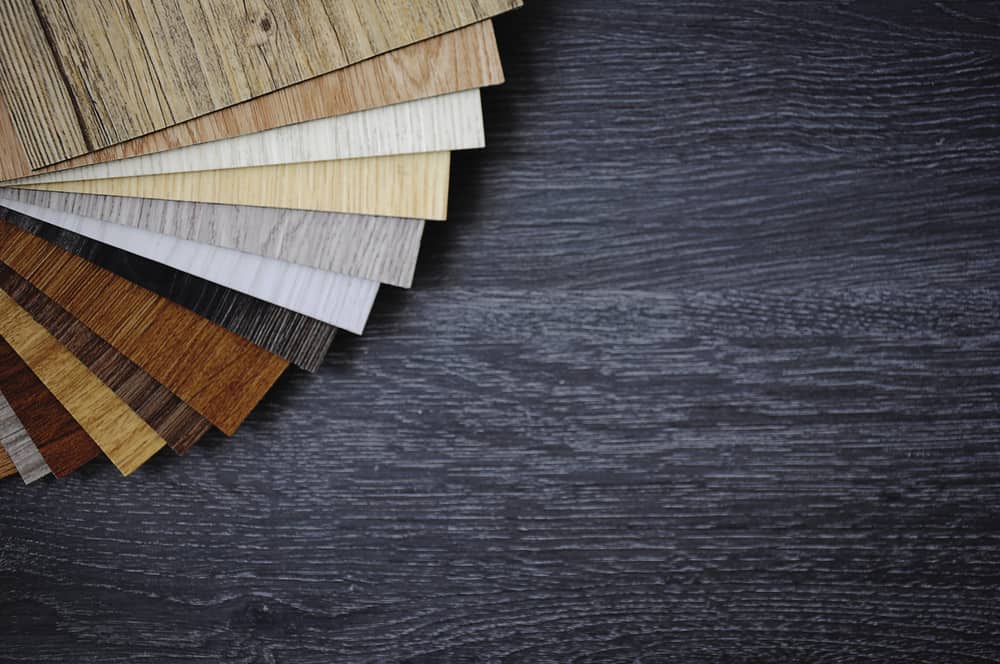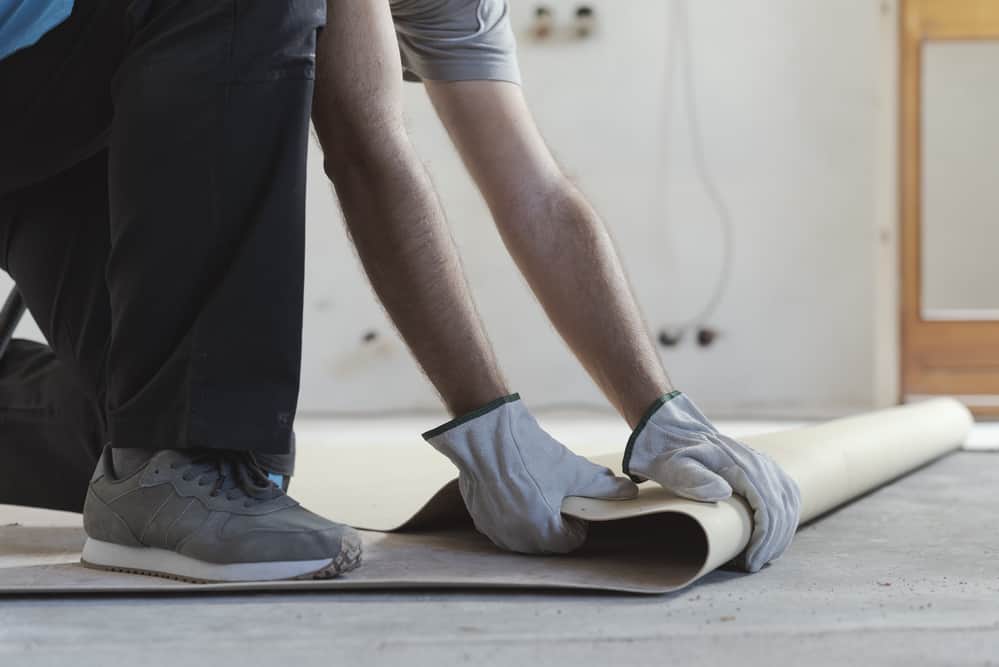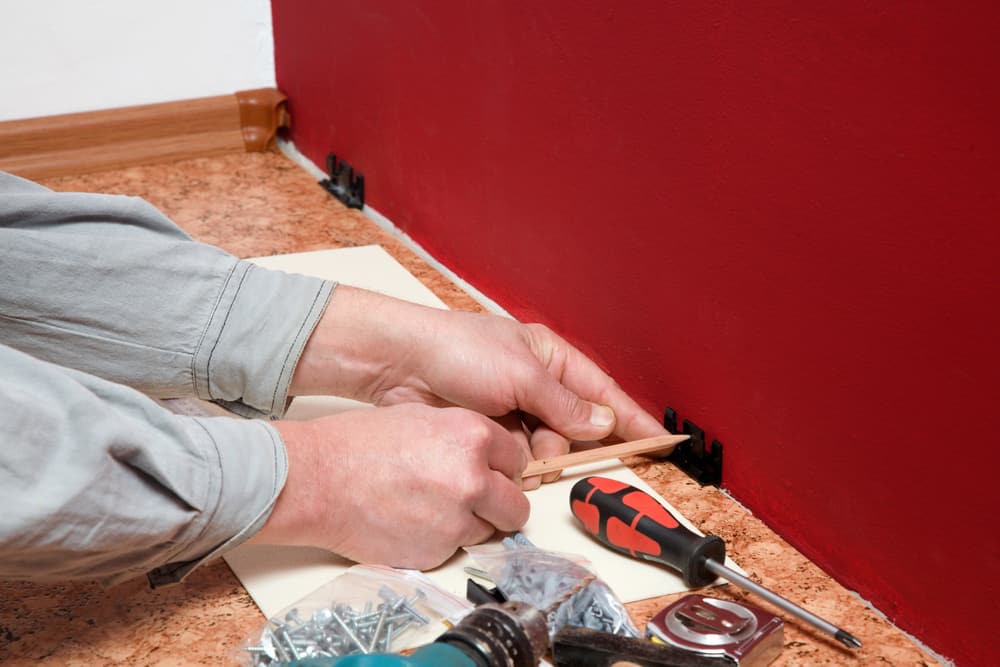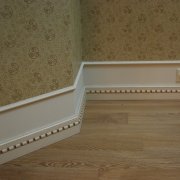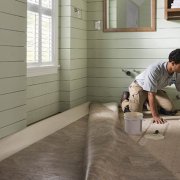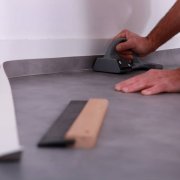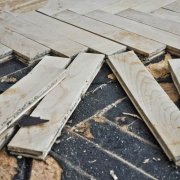How to lay linoleum
Linoleum is an affordable and unpretentious type of floor covering. Thanks to the simplicity of laying, you can lay linoleum with your own hands without involving a construction team. You can lay linoleum in the corridor of the apartment, refine the floor in the bedroom or children's room on your own. To do this, it is desirable to have an initial skill in repair work, to obtain minimal knowledge about this type of installation and to study some nuances in order to avoid irreparable errors.
The content of the article
Material selection
First of all, it is worth deciding on the type of linoleum. Pay attention to the following material parameters:
- what is made of;
- how durable
- what is its structure.
Let's analyze each item in more detail.
Natural linoleum
Its components:
- limestone, increasing the strength of the linoleum coating;
- wood resin, increasing strength properties and flexibility;
- linseed oil - a binder between the other components;
- cork flour, which gives the coating smoothness and is responsible for maintaining the color of the material.
The coating is environmentally friendly, does not cause allergies, is resistant to bacterial influences. The material also has antistatic properties. In addition, natural linoleum repels fat and does not support combustion.
PVC linoleum
The basis of PVC (or polyvinyl chloride linoleum) is a fabric or non-woven, heat-insulating or foamed material.
The coating may have a single layer or be multi-layer. Among the disadvantages of PVC linoleum, there is a large shrinkage and a specific smell, which disappears for a long time.
Relin
Also known as rubber linoleum. It is a two-layer finishing material from bitumen and crushed rubber. The outer layer of religion is rubber and a specific pigmented filler. Among the distinctive characteristics of the coating are ductility and increased resistance to moisture.
Nitrocellulose (collokeylin) linoleum
The material essentially has no basis. Based on nitrocellulose, such linoleum is extremely flammable, therefore it is not recommended for use in the kitchen. Of the advantages of the material: elastic, moisture resistant, shiny and aesthetically pleases on the floor.
Alkaid linoleum
Also known as Giftal linoleum. It is made from pigments, alkaids and woven material. Fragile, but with good heat and sound insulating qualities, alkaide linoleum has earned popularity in the market of finishing materials.
Household goals
If you wondered how to properly lay linoleum, most likely you are planning a repair in an apartment or private house, and not in an office or in a factory.
Coating for domestic use is used in residential buildings. As a rule, this material is made of a foam base or polyester. This is a thin coating with bright ornaments and colors. Soft and unpretentious handling easy to lay. However, with frequent use and heavy loads in a short time, its aesthetic appearance is lost.
Semi-Commercial Goals
Semi-commercial linoleum is suitable if it is necessary to lay the floor in the office room or hotel rooms. The material is also used for domestic purposes, since it is similar to the previous type of flooring, but has a longer service life due to the special protective layer.
Commercial goals
For an enterprise with increased traffic it is better to use a polyvinyl chloride coating. It lasts longer and does not lose its attractive appearance due to the strong top layer.
Material selection by structure
- Heterogeneous linoleum. In fact, it is a multi-layer “sandwich”, which is based on fiberglass, and non-woven fibers, foam structures or fabric are used for the substrate.
- Homogeneous linoleum. The composition of homogeneous linoleum - PVC granules and various dyes, arranged in a homogeneous structure. Such linoleum is resistant to abrasion, therefore, it is recommended for use on objects with high traffic.
- Baseless linoleum. A cheap but short-lived finishing material with a thickness of 1.5 to 3 millimeters. Due to the thinness of the material, do not lay baseless linoleum on an uneven surface.
- The main linoleum. Elasticity allows you to use such linoleum for almost any surface - it will lie flat. The main view is distinguished by the presence of a fabric, non-woven or heat-insulating substrate.
What to consider when choosing linoleum
Knowing how to lay linoleum in general is not enough, because laying material in a bedroom or office is a different task that requires different solutions. When choosing linoleum, we recommend that you pay attention to the following five factors.
Passability
For a large family or office, a more wear-resistant linoleum will be required than for a family of two. You can find out the wear resistance class in international standards. The manufacturer, as a rule, indicates coating markings with the necessary information.
You should also take into account the weight of the furniture in the room: for a "difficult" environment you will need a stronger coating that can withstand pressure.
Color spectrum
In addition to the type of flooring and the number of layers it is important to pay attention to the color of the material. To create comfort in the room, it is better to choose warm tones, and light cold shades will help to visually increase the space of the room.
Color matters when you want to set the mood for your interior. If you want to create a calm, intimate atmosphere, use linoleum of dark tones. If you want an active and creative mood, choose bright colors of the flooring. Not enough freshness and airiness? Then it is better to stay on a light scale.
Interior designers offer to lay a coating of warm tones for the living room - this color is conducive to relaxation. If guests often visit the house and have parties, pay attention to the linoleum of cold tones with clear patterns - this design enhances the mood.
Room size
Before purchasing flooring, draw a plan of the room and calculate its area. The length and width of the room, the number of doorways are important values that must be correctly determined and calculated.
Linoleum coating
If you plan to lay linoleum with your own hands in the kitchen, choose a coating treated with a special varnish that protects against dust and dirt. If the plans are to repair the children's room, it is better to purchase linoleum with antibacterial protection.
Room temperature
Cold floors are a common problem in residential areas. This primarily concerns apartments located on the ground floor. An access door and an unheated basement lower the room temperature. In this case, choose the type of coating that will help maintain heat in the home.
Given the goal, to insulate the floor of the first floor, the owners of the apartment are faced with the question of whether to lay a substrate under linoleum.To deal with this issue, we turn to the manufacturers' requirements for flooring:
- it should be without potholes, cracks, that is, even;
- durable;
- dry, with a moisture tolerance of up to 12% for a wooden base and up to 0% for mineral;
- monolithic;
- tough so that the weight of the furniture and residents does not bend or deform the coating.
It is clear from the last paragraph that it is not recommended to lay a lining for floor insulation. It is better to choose linoleum, which due to its structure will provide additional thermal insulation.
Some contractors believe that linoleum can be laid on linoleum. They argue their opinion by installing a new coating on old linoleum, you will save time, insulate the floor, and avoid dirt that occurs during the dismantling process. However, the consequences of such a decision can be detrimental because:
- A new layer can lie in waves or creases form on it.
- The likelihood of the formation of fungus and mold between the layers.
- It is difficult to repair a deformed coating if the old linoleum lies under it. Another thing is a concrete or wooden base.
Carefully weigh the pros and cons if you decide to lay a new layer on the old linoleum coating.
How is wood laying
If there is no way to pay for the work of the installation team, you can lay the cover without resorting to the help of professionals. To understand how to lay linoleum on plywood or another wooden base yourself, we will consider the process in stages.
Stage No1. Floor preparation
The main task in the first stage is to carefully prepare the wooden floor for installation. It is important to lay linoleum only on an even basis. Otherwise, the unevenness of the floor will lead to the formation of cracks on the coating, it will quickly rub and become unusable.
Even high-strength four-layer linoleum remains a rather thin, elastic product. Therefore, later it will begin to repeat the shape of the surface on which it is laid. This means that the base with bulges and tubercles will significantly reduce the service life.
To linoleum will last a long time:
- Carefully examine the condition of the floor. Correct, remove, and, if necessary, replace boards that have become unusable, creak, stagger, or rot.
- It is advisable to treat the wood with a bioprotective agent, clean the wood from paint, dismantle the baseboard. Next, clean the floor: remove debris, sweep, or rather vacuum the surface. After that - washing and drying the floor.
- If the width of the floor gaps exceeds 4 millimeters, cover them with patches. Stuff all cracks and chips on the floor.
- To align the wooden base to the maximum, deepen the nails and screws in the boards by at least 5 mm, and then process the coating with a grinder.
- Examine the surface for slope - use the building level. If you find a serious height difference - from two millimeters or more - linoleum laying will have to be postponed and floor leveling should be started. The most efficient, convenient and inexpensive way is to use self-leveling mixtures.
About how to level the rough basis of the floor through such compounds, it is worth describing in more detail. The process consists of the following steps.
- Soak the dried floor with a primer. Its main function will be to improve the adhesion of the composition and the wooden base.
- Insulating materials close the walls at the surface of the floor.
- Expanded polystyrene glue the joints between the floor and walls.
- We install a wooden plank in the doorway. She will act as a limiter of flooring.
- We mount the reinforcing mesh. With a construction stapler with an overlap of 5-6 centimeters, we fix the mesh on the base.
- Stir the self-leveling mixture with water. It is important to choose the right proportion, so do not neglect the instructions of the manufacturer of the composition. Pour the solution onto the floor.
- With a spiked rubber roller or a mop (rubber), we evenly distribute the mixture on the floor base.
- We wait until the coating dries.
It is worth noting that if the height difference on the floor is too large, then it makes no sense to use a self-leveling mixture. In this case, it is better to lay a special substrate on a wooden base.
As the material for the substrate, plywood, wood-shaving products or MDF sheets with a thickness of 5 to 8 millimeters are most often used:
- The substrate sheets are laid on the floor so that they are displaced relative to each other by approximately half their length and have no gaps between them. At the base of the walls, on the contrary, it is necessary to provide gaps of about 1 centimeter.
- To avoid voids and irregularities, before starting laying the floor is treated with a composition of PVA glue and building gypsum, or with special mastic.
- When the voids are filled with mortar, the installation of plywood begins. Universal self-tapping screws fix the substrate every 15-20 cm. So that the screws do not protrude above the surface of the wood, it is better to deepen them as far as possible into the plywood sheet.
- If possible - putty and polish the surface after fixing.
- When the plywood is laid and fixed, it is covered with quick-drying floor paint or hot drying oil to treat the base.
- After the paint has dried, proceed to the linoleum flooring.
Stage No2. Necessary tools
Starting the installation process, make sure that the house has the necessary tools:
- Marker and tape measure.
- Vacuum cleaner (preferably building).
- Knife for cutting materials.
- Level or steel rail.
- Short-nap roller or notched trowel - they are convenient to apply an adhesive base.
- A roller (rubber or velor), a sailing trowel, or a lapping board - will be needed at the stage of smoothing the linoleum coating to the base.
- Adhesive tape (preferably double-sided) or masking tape.
- Reinforcing or adhesive primer and adhesive mixture for fixing the material.
- Glue for joining the seam, for example, fixer from the “cold welding” series. Such glue fuses parts of the canvas into a barely noticeable, monolithic joint.
- A set of skirting boards and decorative metal or PVC thresholds.
Stage No3. Stacking
Allow linoleum to rest for some time before installation. The air temperature in the room should not fall below 18C, and the humidity should be 60-70%. If you ignore these requirements, the coating is deformed. To keep the material even and well laid, unfold linoleum on the floor and leave it for 24 hours.
Then proceed to the installation:
- We measure the width and length of the room, not forgetting to take into account the doorways. To the obtained values we add another 7-8 cm for the holidays provided for the curvature of the walls.
- Cut the linoleum according to the markup. It is advisable to do this on a ruler for evenness of cut.
- It is better to lay the coating from the most even wall. We place the coating close to the wall or leave a slight gap - the excess will be cut off.
- We fix linoleum cuts on the floor with double-sided tape so that there is no material displacement during trimming.
- We connect slices with an overlap of 2-3 centimeters. We adjust the drawing so that the ornament on one part matches the ornament on the other piece.
- After fixing the linoleum on the base, we trim it along the walls. We cut off a little so as not to cut off the excess and not spoil the material.
- We put glue on the base with a spatula. The process is better to start from the junction.
- When the glue is applied, we begin rolling the linoleum. Make sure that no air remains under the canvas. Then we check the joints again, if necessary, do repeated trimming. If everything is smooth, we begin rolling joints.
On this linoleum laying is over. It remains to wait until the glue has completely dried and establish a joint profile.
Glueless laying
How to lay linoleum with a glueless method, it is worth knowing to the owners of small apartments.If the size of the flooring is not inferior to the area of the room and its enhanced operation is not planned, you can resort to a glueless laying method.
The installation process in this case will consist of the following steps:
- We spread the coating around the perimeter, carefully cut it. Similarly to glue laying, we leave overlaps on the walls (6-8 cm).
- We glue the working area with double-sided tape and lay linoleum on it.
- Starting from the center of the room, smooth the coating with your hands. To fit the material with the highest density, we cut it in the corners.
- Carefully turn off part of the linoleum and, removing the adhesive tape film, return the coating to its place, while tightly pressing it to the floor and pulling it a little.
- For additional fixation we use a plinth. When nailing the skirting board, it is important to monitor the density of their fit to the coating.
How to work with concrete
It is quite simple to lay linoleum on a concrete base with your own hands. It is only necessary that the surface is smooth, and most importantly - dry. Installation is as follows:
- We release the floor from the old coating.
- We get rid of cracks and irregularities by treating the floor with a self-leveling compound. When the mixture is completely dry, proceed to styling.
If there are significant potholes and bumps on the concrete, you will have to make a new screed. The laying process itself is simple, difficulties appear only when dismantling the old concrete screed.
Skirting Installation Features
The final stage of installation is the installation of skirting boards. Here it is also worth paying attention to some nuances. If the budget is limited, purchase plastic skirting boards with a cable channel mounted in them. So the wires will not get in the way, and the room will become tidier. Wooden baseboards look expensive and beautiful. If you are willing to pay more for the appearance, choose this type of baseboard.
Install the baseboard as follows:
- Installation begins from the corner of the longest wall. We take the remaining trim to stroke the shorter sides and corners.
- We cut the plastic baseboard with a hacksaw. To fix the baseboard every 20-25 centimeters we use self-tapping screws. If the wall is concrete or brick, you will need a hammer drill for drilling holes.
Aftercare
To make linoleum last longer, immediately after installation, polish the surface and treat it with a dirt repellent. Repeat this cleaning every six months.
Daily cleaning of the coating is reduced to washing with a damp cloth with a small addition of detergents (preferably liquid soap).
Choose furniture not on legs, but on polyurethane rollers. Rubber rollers often leave traces. If you have such furniture, try not to roll it, but to move it.
Laying linoleum on the floor: video
The video shows a brief instruction on laying linoleum, which will allow you to assess the scale of the work.

